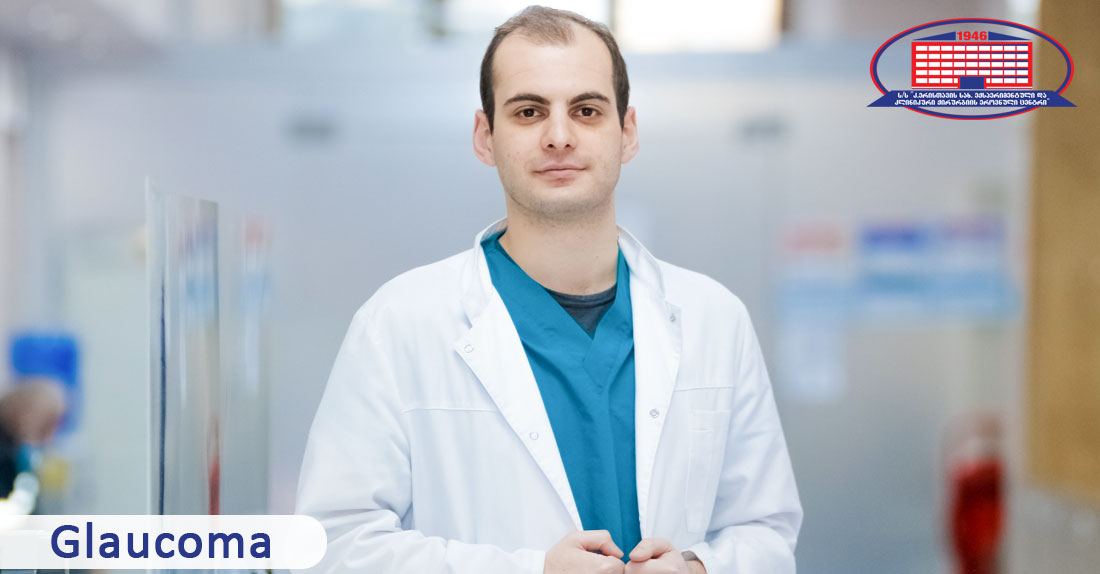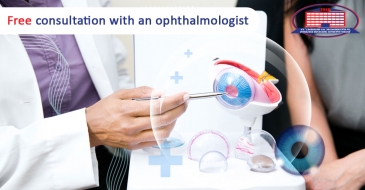
The National Center of Surgery treats ophthalmic pathologies, such as „glaucoma”
In the interview you will learn the following information:
- Definition of the disease;
- Signs and symptoms;
- Risk groups;
- Disease prevention;
- Diagnostic-laboratory studies;
- Treatment;
- The ophthalmologist recommends.
The term „glaucoma" combines about 60 groups of eye diseases. This pathology develops characteristic lesions of the optic nerve disc and retinal ganglion cells (glaucoma optic neuropathy). About disorders characteristic of glaucoma of visual functions we are talking to Konstantine Chikovani, a member at the National Center of Surgery, European Society of Cataract and Refractive Surgeons (ESCRS), ophthalmic surgeon.
– Mr. Konstantine, what is glaucoma?
–It is not a single disease, it is a group of certain conditions that cause damage to the optic (vision) nerve damage, resulting in vision deterioration. The reason for this is mostly increased pressure inside the eye (intraocular pressure). It is one of the most severe eye diseases, characterized by rapid progression and causing irreversible blindness. As I mentioned, pathology includes not one, but a group of different types of damage to the organ of vision, in which there is a constant or periodic increase in intraocular pressure, decreased visual acuity, and reduction of nerve atrophy (optic neuropathy). The pathological process begins with the deterioration of lateral (peripheral) vision and it usually has no symptoms at an early stage, besides significant deterioration of vision, abrupt reduction, or complete loss.
– What are the symptoms of „glaucoma“?
– At such times the symptoms are manifested according to the forms of the disease.
The most common forms are primary open-angle and acute closed-angle. At such time we have a completely different clinical image.
Symptoms of primary open-angle glaucoma are:
- A gradual loss of peripheral vision, often- in both eyes;
- Narrowing of the visual field in distant stages.
Symptoms of acute closed-angle glaucoma are:
- Severe pain in the eyes;
- Nausea and vomiting (accompanied by severe pain in the eyes);
- Sudden onset of vision impairment, often in low light;
- Blurred vision;
- Visual rings in bright light;
- Redness of the eyes.
– Who is at risk-group of developing pathology?
– In general, people over the age of 60 have an increased risk of developing glaucoma. However, family history is important - whether any of the patient's family members had the disease, as hereditary predisposition is often noted. Its development is also expected in diabetes, hypertension (high blood pressure), heart disease, and hypothyroidism (decreased thyroid function). Severe, traumatic eye injury also increases intraocular pressure. Other risk factors include retinal detachment and inflammatory diseases such as uveitis (inflammation of the middle membrane of the eye).
– Mr. Konstantine, what would you recommend to the patients for disease prevention?
–It is necessary to make a scheduled visit to the ophthalmologist at least once a year, and in case of complaints, you should immediately consult a doctor. It often develops unnoticed by the patient, which is why delayed referrals are so common. With timely diagnosis, it is possible to stop the progression of the disease and its proper management.
– What is the method of diagnosis?
–Tonometry- This procedure measures the intraocular pressure. This is the initial screening test to detect the disease. We also refer to research methods such as:
- Test to detect optic nerve damage. An ophthalmologist uses an instrument (OCT) to check the condition of the optic nerve fibers, which allows the doctor to view the back of the eye directly through the gouge. With the help of this examination it is possible to detect glaucoma at an early stage;
- Check peripheral (lateral) vision to see if the field of vision is damaged by glaucoma;
- Gonioscopy - with this method, special lenses are placed on the eyes to assess the drainage angle.
Only an early diagnosis can provide effective treatment and prevent the development of blindness. Because increased intraocular pressure harms the optic nerve - the blood supply deteriorates, and after a while, the nerve „dies".
– How do you treat glaucoma at the National Center of Surgery?
– We use the most modern approaches in the treatment of glaucoma in our clinic. Currently, it is impossible to completely cure it, however, correct and timely diagnosis allows us to prevent the progression of the disease. In general, the choice of treatment depends on the severity of the pathological changes, the symptoms, the form of the disease, and includes medical treatment, surgical or laser therapy. The purpose of all this is to reduce intraocular pressure, normalize the blood supply to the optic nerve and improve metabolic processes in the structures of the eye tissue. In case of the acute form, corrective iridectomy (removal of the damaged part of the colored membrane of the eye) is performed in our clinic to normalize fluid drainage. Most importantly, the treatment plan is chosen individually for each patient, which ensures proper management of the disease.
– How important is proper nutrition for good eyesight?
–The organ of sight is connected to our body by blood vessels; Even the problems caused by unhealthy eating will affect our eyesight. Subsequently, proper nutrition is essential. To prevent glaucoma, you need to include raw vegetables, fish, fruits in your diet, and reduce the number of animal fats and sugars in your diet.
It should be noted, that physical activity helps to normalize blood circulation in the visual system. However, for the prevention of pathology, it is necessary to exclude lifting weights (only 3-10 kg is allowed). As for patients diagnosed with glaucoma, they are generally forbidden to lift weights (only 2 kg is allowed).
Eyesight is improved with vitamins A, B, and C, as well as foods rich in potassium. Their maximum quantity is found in such a natural product as:
- Carrots;
- Bulgarian pepper;
- Apricots;
- Peach;
- Kiwi;
- Citrus;
- Cranberries/Blueberries;
- Rosa canina;
- Crataegus/hawthorn.
Taken on an empty stomach beet and carrot juice helps to significantly improve eyesight.
Wish you health!
What are patients interested in
Demodicosis
Qauestion:: As a result of ocular demodicosis treatment (Blefarogel 2), hyperplasia of the eyelash follicles occurred. As a stratum mass of the occluded area. No changes in one year. Is there any solution? Eyelashes grow in different directions.









